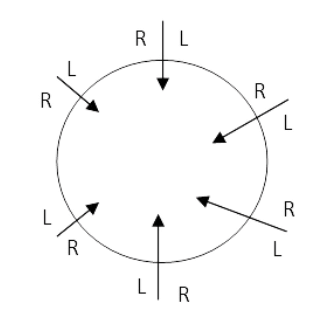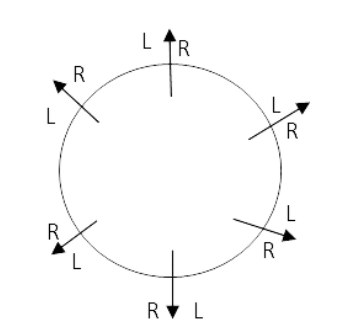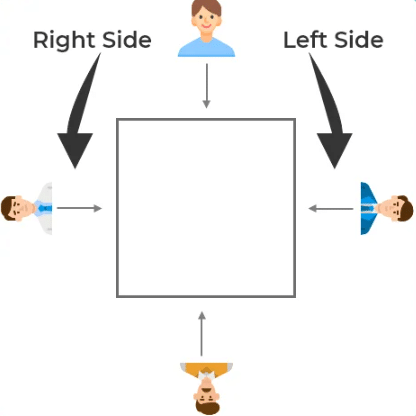Tips & Tricks for Seating Arrangement | General Test Preparation for CUET UG - CUET Commerce PDF Download
The questions on seating arrangement are regular feature of almost every competitive examination. In these questions, you have to arrange a group of persons fulfilling certain conditions. This is also written as sitting arrangement or sitting arrangement reasoning at some places.

Types of Seating Arrangements
Linear Seating Arrangement: In questions related to linear arrangements, individuals are positioned in a straight line, requiring students to organize them accordingly. Typically, a single row of seating is formed in these questions.
Double Row Seating Arrangement: Double row arrangement questions involve two groups of individuals. Students must arrange one group in the first row and the other in the second row. Individuals in these rows usually face each other, with one row oriented towards the North and the other towards the South.
Circular Seating Arrangement: Circular arrangement questions entail organizing people around a circular table. There are primarily three types of questions in circular seating arrangements:
a. Circular arrangement with people facing the center of the table.
b. Circular arrangement with people facing outward from the table.
c. Circular arrangement with people facing the center of the table while some face outward.Square/Rectangular Seating Arrangement: In square/rectangular arrangement questions, individuals are positioned around a square or rectangular table. These questions are akin to circular seating arrangement questions, encompassing inward-facing, outward-facing, or both-sided arrangements.
How to Solve Seating Arrangement Problems
Questions on seating arrangement are generally asked in blocks of 4 – 5 questions. You are given some information and then there will 4 -5 questions based on the information. These questions have two types of information:
1. Direct information: This is the information which is clearly mentioned in the statement of the question. This is the information which you will use when you start solving the questions.
2. Indirect information: After filling the direct information you will look for the connection between different parts of the information. These connections form the indirect information.
While arranging the persons, the direction to which the persons are facing is very important.
- Let us take the case of linear arrangements. Here if it is stated that there are five persons sitting facing North then the arrangement will be like

- On the other hand if these persons are sitting facing South then the arrangement will be like

- Similarly if the arrangement is a double row arrangement, then one group of people will be facing north and the second will face south and the directions will be taken as similar to the above figures.
- In circular or rectangular arrangements, people can face towards the center or away from it.
If they face the center, the right side is in the anticlockwise direction, and the left side is in the clockwise direction.

- If people are facing outward, the right side will go clockwise and the left side will go anticlockwise, as illustrated below.

- The same concept of directions follows if the persons are sitting around a rectangular table.
Formulas for Seating Arrangement
Linear Seating Arrangement:
- Adjacent Seats: Consider two individuals sitting next to each other as a single unit for arrangement purposes.
Circular Seating Arrangement:
- Clockwise and Counterclockwise: Keep track of both clockwise and counterclockwise positions when arranging individuals in a circular pattern.
Rectangular Table Seating:
- Rows and Columns: Identify rows and columns in a rectangular table for better organization.
- Facing Each Other: When individuals face each other, they occupy opposite corners of the rectangle.
Grouping and Arrangement:
- Clusters or Groups: If the arrangement involves grouping, form clusters based on related conditions.
- Group Arrangements: Arrange individuals within the group according to specific conditions.
Fixed Positions and Constraints:
- Fixed Elements: Place elements with fixed positions first, as they serve as reference points for arranging others.
- Using Constraints: Utilize given constraints to eliminate invalid positions and refine the arrangement.

Terms Related to Seating Arrangements
- Adjacent: Individuals or items that are next to each other in the arrangement, either horizontally or vertically.
- Alternate: A pattern where individuals or items are placed in every other position, skipping one in between.
- Between: Refers to an individual or item positioned in the middle of two others.
- Clockwise: A direction that follows the movement of a clock’s hands, typically used in circular seating arrangements.
- Counter-clockwise: The opposite direction to the movement of a clock’s hands, commonly used in circular seating scenarios.
- Diagonal: Individuals or items that are placed diagonally across from each other in the arrangement.
- Facing: When individuals or items are oriented to look at each other directly, often used in circular arrangements.
- Opposite: Individuals or items positioned directly across from each other, often used in circular or linear arrangements.
Tips and Tricks for Seating Arrangements
- First, quickly look over the information provided to grasp the situation of the people.
- Sort out each piece of information based on its practicality.
- To avoid confusion about left and right in circular and square/rectangular arrangements, assume all people are facing the center unless otherwise stated.
- If someone's position is not directly mentioned but is described in relation to others, it's comparative information.
- If a person's position is explicitly stated, it's definite information.
- Negative information doesn't provide direct details but helps eliminate possibilities.
- When solving these questions, imagine yourself among the group for clarity. Start by focusing on statements that are definitely true.
- Then, consider statements with negative or indirect information.
- If multiple possibilities exist, create different diagrams for each and eliminate those that contradict other information.
- Eventually, you'll arrive at the final diagram.
|
164 videos|630 docs|1146 tests
|
FAQs on Tips & Tricks for Seating Arrangement - General Test Preparation for CUET UG - CUET Commerce
| 1. What are some common types of seating arrangements? |  |
| 2. How can seating arrangement problems be solved effectively? |  |
| 3. What are some key formulas used for seating arrangements? |  |
| 4. What terms are related to seating arrangements? |  |
| 5. What are some tips and tricks for solving seating arrangement problems? |  |





















